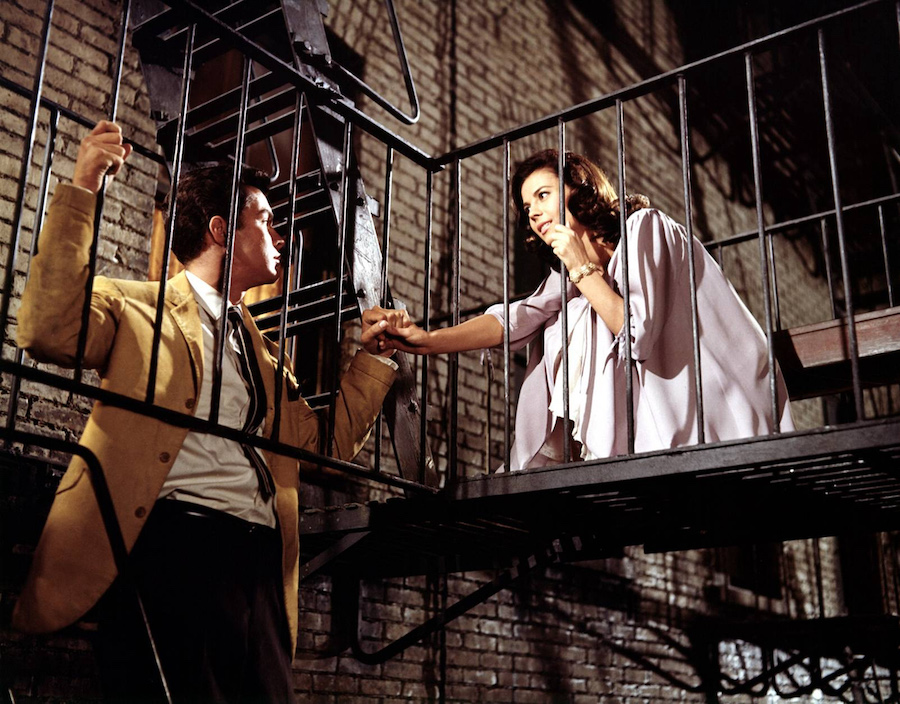
THE SCREEN ACHIEVES ONE OF THE GREAT ENTERTAINMENTS IN THE HISTORY OF MOTION PICTURES.

Stage director Jerome Robbins was a key reason why ”West Side Story” became a groundbreaking Broadway hit in 1957. When the time came to make a movie, the studio had it both ways. Apart from the music and the show’s artistic expression, it’s also a story full of social criticism. That’s why Robert Wise was chosen to direct; he knew New York City and could deliver gritty realism, as he did in Odds Against Tomorrow (1959). But Wise had no experience from making musicals, so he agreed to let Robbins handle the choreography and dance sequences.
Eventually, Robbins was fired by the studio after going over budget and almost suffering a nervous breakdown. Wise made most of the movie, but didn’t mind sharing the credit. After all, without Robbins there would be no West Side Story.
Two gangs at each other’s throats
In the Lincoln Square neighborhood in Manhattan, there is a constant feud between two youth gangs, the Jets and the Sharks, who are divided by racial lines. The Jets want to make the neighborhood white again, while the Sharks are Puerto Rican and want their share. At the same time, local cops do their best to make sure that no one is killed. When a dance is organized in the neighborhood, both gangs are there.
Suddenly, two people see each other for the first time and there is instant infatuation – between Maria (Natalie Wood), the younger sister of Sharks leader Bernardo Nunez (George Chakiris), and Tony (Richard Beymer) who’s part of the Jets. They secretly start seeing each other… but the competition between the two gangs threatens to tear them apart.
A musical with a social message
The original story was inspired by Shakespeare’s ”Romeo and Juliet”, and it is certainly a tragedy with an unusually serious social message for a Broadway audience that wasn’t quite used to it. Depicting a neighborhood that was blue-collar and pretty worn down at the time, the story focuses on the evil of racism and male rivalry, a toxic combination standing in the way of true love. The message was made even clearer, in a more interesting way, as the lyrics of one of the musical’s many famous songs, ”America”, changed in the transition from stage to screen. The original version was believed to be a little too condescending toward Puerto Rico; making the lyrics not only praise everything that’s great about America, but also answer with everything that’s negative, creates a now-classic dynamic that ingeniously symbolizes the tension between Maria and her brother.
The feud between the gangs is depicted in an almost startling, stylized (often parodied) way
The romance between Maria and Tony is so vibrant largely because of the beautiful songs that accompany it and how they are staged. Wood and Beymer don’t quite match that intensity, especially also since their singing voices belong to other people, Marni Nixon and Jimmy Bryant. But musically and artistically this is so much more than about the romance. The feud between the gangs is depicted in an almost startling, stylized (often parodied) way, with the gang members performing balletic dances that symbolize their attitude and aggression toward enemies. There is a lot of rivalry and competition in the songs, even a moment where the gang members get to mock the cops who are always after them (”gee, officer Krupke, krup you!”).
This beautiful, vivid film maintains its artistic expression from the stage, most evident in the choreography and production design, but finds a balance between that and the realism. The filmmakers included a wonderful opening journey over Manhattan skyscrapers that take us from that quiet urban sight from up in the air right down to a more squalid place where heated human emotions come to a boil.
West Side Story 1961-U.S. 151 min. Color. Widescreen. Produced by Robert Wise. Directed by Robert Wise, Jerome Robbins. Screenplay: Ernest Lehman. Book: Arthur Laurents. Cinematography: Daniel L. Fapp. Music: Leonard Bernstein, Irwin Kostal. Songs: Leonard Bernstein, Stephen Sondheim (”Maria”, ”Jet Song”, ”America”, ”Tonight”, ”I Feel Pretty”, ”Somewhere”). Editing: Thomas Stanford. Production Design: Boris Leven. Costume Design: Irene Sharaff. Cast: Natalie Wood (Maria Nunez), Richard Beymer (Tony Wyzek), George Chakiris (Bernardo Nunez), Rita Moreno (Anita), Russ Tamblyn, Tucker Smith… John Astin.
Trivia: Elvis Presley, Warren Beatty, Richard Chamberlain and Robert Redford were considered as Tony; Audrey Hepburn and Jill St. John as Maria. Saul Bass created the ending title sequence. Remade as West Side Story (2021).
Oscars: Best Picture, Director, Supporting Actor (Chakiris), Supporting Actress (Moreno), Cinematography, Film Editing, Music, Art Direction-Set Decoration, Costume Design, Sound. Golden Globes: Best Motion Picture (Musical), Supporting Actor (Chakiris), Supporting Actress (Moreno).
Last word: “When we did the rape scene during rehearsals when they were mauling me and all that, the boys. I pushed them away, and started to cry, and I could not stop. All of those scars that I thought were healed just opened up. I was like a wounded animal when I did it again. That is – yes when she says, ‘Don’t you touch me.’ And I thought, ‘How would Marlon [Brando] say that as an actor?’ And it was through my teeth ‘Don’t you touch me.’ That is the scene that I know got me the Oscar.” (Moreno, CBS News)
